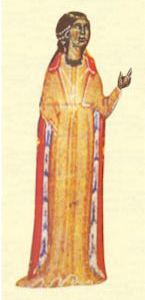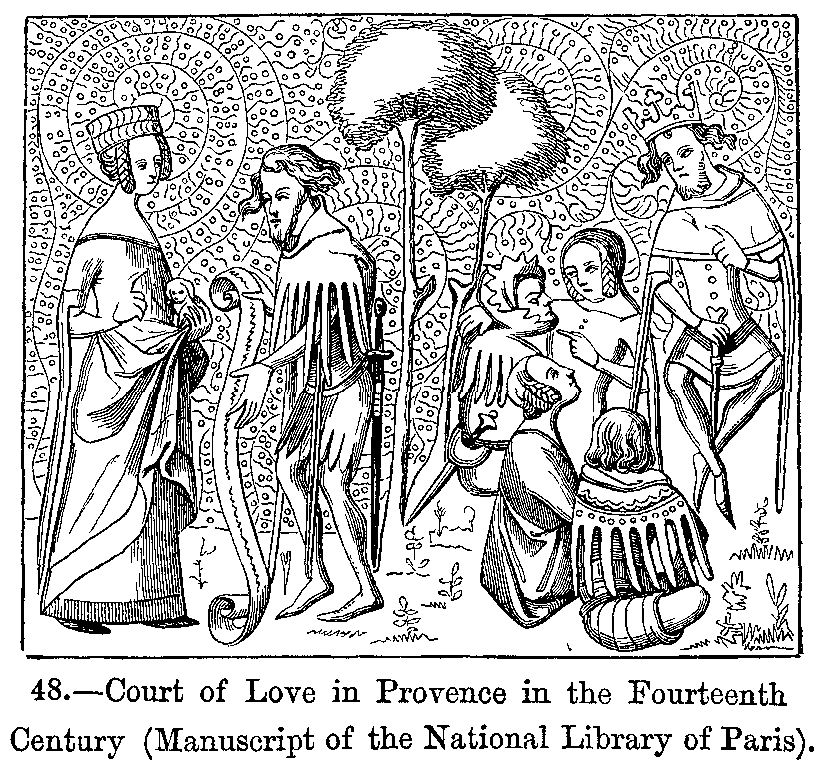|
Troubadour
A troubadour (, ; ) was a composer and performer of Old Occitan lyric poetry during the High Middle Ages (1100–1350). Since the word ''troubadour'' is etymologically masculine, a female equivalent is usually called a ''trobairitz''. The troubadour school or tradition began in the late 11th century in Occitania, but it subsequently spread to the Italian and Iberian Peninsulas. Under the influence of the troubadours, related movements sprang up throughout Europe: the Minnesang in Germany, '' trovadorismo'' in Galicia and Portugal, and that of the trouvères in northern France. Dante Alighieri in his '' De vulgari eloquentia'' defined the troubadour lyric as ''fictio rethorica musicaque poita'': rhetorical, musical, and poetical fiction. After the "classical" period around the turn of the 13th century and a mid-century resurgence, the art of the troubadours declined in the 14th century and around the time of the Black Death (1348) and since died out. The texts of troubado ... [...More Info...] [...Related Items...] OR: [Wikipedia] [Google] [Baidu] |
Trouvère
''Trouvère'' (, ), sometimes spelled ''trouveur'' (, ), is the Northern French ('' langue d'oïl'') form of the '' langue d'oc'' (Occitan) word ''trobador'', the precursor of the modern French word '' troubadour''. ''Trouvère'' refers to poet-composers who were roughly contemporary with and influenced by the ''trobadors'', both composing and performing lyric poetry during the High Middle Ages, but while the ''trobadors'' composed and performed in Old Occitan, the ''trouvères'' used the northern dialects of France. One of the first known ''trouvères'' was Chrétien de Troyes ( 1160s–1180s) and the ''trouvères'' continued to flourish until about 1300. Some 2130 ''trouvère'' poems have survived; of these, at least two-thirds have melodies. Etymology The etymology of the word ''troubadour'' and its cognates in other languages is disputed, but may be related to ''trobar'', "to compose, to discuss, to invent", cognate with Old French ''trover'', "to compose something in ... [...More Info...] [...Related Items...] OR: [Wikipedia] [Google] [Baidu] |
Trobairitz
The ''trobairitz'' () were Occitania, Occitan female troubadours of the 12th and 13th centuries, active from around 1170 to approximately 1260. ''Trobairitz'' is both singular and plural. The word ''trobairitz'' is first attested in the 13th-century romance (heroic literature), romance ''Romance of Flamenca, Flamenca''. It comes from the Provençal word ''trobar'', the literal meaning of which is "to find", and the technical meaning of which is "to compose". The word ''trobairitz'' is used very rarely in medieval Occitan language, Occitan, as it does not occur in lyrical poetry, grammatical treatises or in the Vida (Occitan literary form), biographies (''vidas'') of the ''trobairitz'' or troubadours. It does occur in the treatise ''Doctrina d'acort'' by Terramagnino da Pisa, written between 1282 and 1296. He uses it as an example of a word the plural and singular of which are the same..: "which are correctly used only with flexional endings in all numbers ... ''trobayritz''" ('' ... [...More Info...] [...Related Items...] OR: [Wikipedia] [Google] [Baidu] |
Courtly Love
Courtly love ( ; ) was a medieval European literary conception of love that emphasized nobility and chivalry. Medieval literature is filled with examples of knights setting out on adventures and performing various deeds or services for ladies because of their "courtly love". This kind of love was originally a literary fiction created for the entertainment of the nobility, but as time passed, these ideas about love spread to popular culture and attracted a larger literate audience. In the High Middle Ages, a "game of love" developed around these ideas as a set of social practices. "Loving nobly" was considered to be an enriching and improving practice. Courtly love began in the ducal and princely courts of Aquitaine, Provence, Champagne, ducal Burgundy and the Norman Kingdom of Sicily at the end of the eleventh century. In essence, courtly love was an experience between erotic desire and spiritual attainment, "a love at once illicit and morally elevating, passionate and disc ... [...More Info...] [...Related Items...] OR: [Wikipedia] [Google] [Baidu] |
Trovadorismo
In the Middle Ages, the Galician-Portuguese lyric, also known as troubadorism, from ''trovadorismo'' in Portuguese and ''trobadorismo'' in Galician, was a lyric poetic school or movement. All told, there are around 1680 texts in the so-called secular lyric or ''lírica profana'' (see Cantigas de Santa Maria for the religious lyric). At the time Galician-Portuguese was the language used in nearly all of Iberia for lyric (as opposed to epic) poetry. From this language derives both modern Galician and Portuguese. The school, which was influenced to some extent (mainly in certain formal aspects) by the Occitan troubadours, is first documented at the end of the twelfth century and lasted until the middle of the fourteenth, with its zenith coming in the middle of the thirteenth century, centered on the person of Alfonso X, ''The Wise King''. It is the earliest known poetic movement in Galicia or Portugal and represents not only the beginnings of but one of the high points of poet ... [...More Info...] [...Related Items...] OR: [Wikipedia] [Google] [Baidu] |
Canso (song)
The ''canso'' or ''canson'' or ''canzo'' () was a song style used by the troubadours. It was, by far, the most common genre used, especially by early troubadours, and only in the second half of the 13th century was its dominance challenged by a growing number of poets writing ''coblas esparsas''. The ''canso'' became, in Old French, the ''grand chant'' and, in Italian, the ''canzone''. Structure A ''canso'' usually consists of three parts. The first stanza is the ''exordium'', where the composer explains his purpose. The main body of the song occurs in the following stanzas, and usually draw out a variety of relationships with the ''exordium''; formally, aside from the ''envoi''(''s''), which are not always present, a ''canso'' is made of stanzas all having the same sequence of verses, in the sense that each verse has the same number of metrical syllables. This makes it possible to use the same melody for every stanza. The sequence can be extremely simple, as in ''Can vei la l ... [...More Info...] [...Related Items...] OR: [Wikipedia] [Google] [Baidu] |
Occitania
Occitania is the historical region in Southern Europe where the Occitan language was historically spoken and where it is sometimes used as a second language. This cultural area roughly encompasses much of the southern third of France (except the French Basque Country and French Catalonia) as well as part of Spain ( Aran Valley), Monaco, and parts of Italy ( Occitan Valleys). Occitania has been recognized as a linguistic and cultural concept since the Middle Ages. The territory was united in Roman times as the '' Seven Provinces'' () and in the Early Middle Ages (''Aquitanica'' or the Visigothic Kingdom of Toulouse, or the share of Louis the Pious following Thionville ''divisio regnorum'' in 806). Currently, the region has a population of 16 million, and between 200,000 and 800,000Fabrice BERNISSAN (2012). "Combien l'occitan compte de locuteurs en 2012 ?", ''Revue de Linguistique Romane'', 76 (12/2011-07/2012), pp. 467-512« De fait, le nombre des locuteurs de l� ... [...More Info...] [...Related Items...] OR: [Wikipedia] [Google] [Baidu] |
Satire
Satire is a genre of the visual, literary, and performing arts, usually in the form of fiction and less frequently non-fiction, in which vices, follies, abuses, and shortcomings are held up to ridicule, often with the intent of exposing or shaming the perceived flaws of individuals, corporations, government, or society itself into improvement. Although satire is usually meant to be humorous, its greater purpose is often constructive social criticism, using wit to draw attention to both particular and wider issues in society. Satire may also poke fun at popular themes in art and film. A prominent feature of satire is strong irony or sarcasm—"in satire, irony is militant", according to literary critic Northrop Frye— but parody, burlesque, exaggeration, juxtaposition, comparison, analogy, and double entendre are all frequently used in satirical speech and writing. This "militant" irony or sarcasm often professes to approve of (or at least accept as natural) th ... [...More Info...] [...Related Items...] OR: [Wikipedia] [Google] [Baidu] |
Trobar Leu
The ''trobar leu'' (), or light style of poetry, was the most popular style used by the troubadours. Its accessibility gave it a wide audienc See also *'' Trobar ric'' *''Trobar clus ''Trobar clus'' (), or closed form, was a complex and obscure style of poetry used by troubadours for their more discerning audiences, and it was only truly appreciated by an elite few. It was developed extensively by Marcabru and Arnaut Daniel, ...'' Old Occitan literature Western medieval lyric forms {{Poetry-stub References # Ruud, Jay. “Trobar Leu.” ''Encyclopedia of Medieval Literature, Second Edition'', Facts On File, 2014. ''History Research Center'', online.infobase.com/Auth/Index?aid=195926&itemid=WEHRC&articleId=44000. ... [...More Info...] [...Related Items...] OR: [Wikipedia] [Google] [Baidu] |
Trobar Ric
The ''trobar ric'' (), or rich form of poetry, was a trobadour style. It was distinguished by its verbal gymnastics; its best exponent was Arnaut Daniel. Despite the fact that it outlasted trobar clus, it always played a secondary role to trobar leu. See also *''Trobar leu'' *''Trobar clus ''Trobar clus'' (), or closed form, was a complex and obscure style of poetry used by troubadours for their more discerning audiences, and it was only truly appreciated by an elite few. It was developed extensively by Marcabru and Arnaut Daniel, ...'' External links Cunnan wiki source (GFDL) {{Western medieval lyric forms Old Occitan literature Western medieval lyric forms ... [...More Info...] [...Related Items...] OR: [Wikipedia] [Google] [Baidu] |
Trobar Clus
''Trobar clus'' (), or closed form, was a complex and obscure style of poetry used by troubadours for their more discerning audiences, and it was only truly appreciated by an elite few. It was developed extensively by Marcabru and Arnaut Daniel, but by 1200 its inaccessibility had led to its disappearance. Among the imitators of Marcabru were Alegret and Marcoat, who claimed himself to write ''vers contradizentz'' (contradictory verses), indicative of the incomprehensibility of the ''trobar clus'' style. Below is a sample of the style from Marcoat's '' sirventes'' ''Mentre m'obri eis huisel'', wherein the poet himself remarks on his ''moz clus'' (closed words): :''Mon ''serventes'' no val plus,'' :''que faitz es de bos moz clus'' :''apren lo, Domeing Sarena.''Chambers, 91. Among the late twelfth-century practitionars of ''trobar clus'' was Peire d'Alvernhe, an imitator of Marcabru, while Raimbaut d'Aurenga of the '' trobar ric'' style was influenced by Marcoat. The only troba ... [...More Info...] [...Related Items...] OR: [Wikipedia] [Google] [Baidu] |
Genre
Genre () is any style or form of communication in any mode (written, spoken, digital, artistic, etc.) with socially agreed-upon conventions developed over time. In popular usage, it normally describes a category of literature, music, or other forms of art or entertainment, based on some set of stylistic criteria, as in literary genres, film genres, music genres, comics genres, etc. Often, works fit into multiple genres by way of borrowing and recombining these conventions. Stand-alone texts, works, or pieces of communication may have individual styles, but genres are amalgams of these texts based on agreed-upon or socially inferred conventions. Some genres may have rigid, strictly adhered-to guidelines, while others may show great flexibility. The proper use of a specific genre is important for a successful transfer of information ( media-adequacy). Critical discussion of genre perhaps began with a classification system for ancient Greek literature, as set out in Aristotle' ... [...More Info...] [...Related Items...] OR: [Wikipedia] [Google] [Baidu] |




